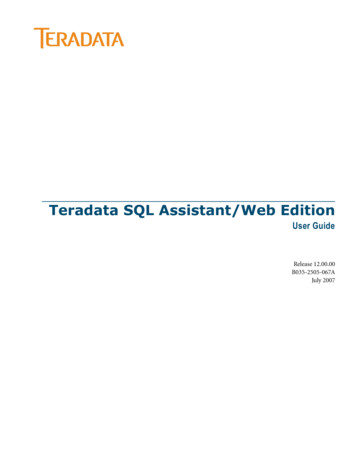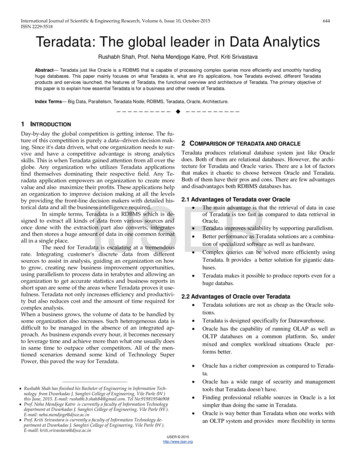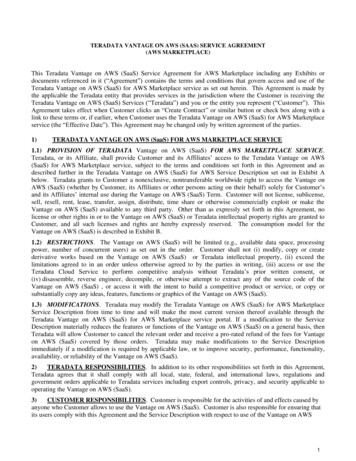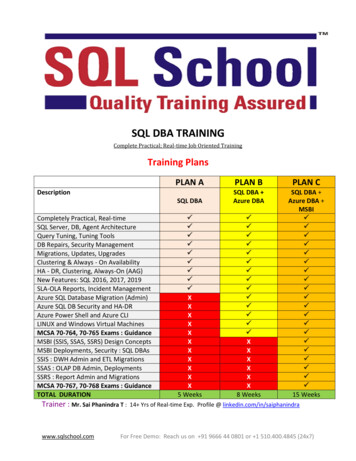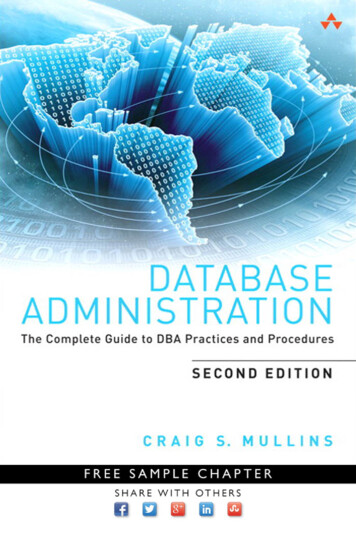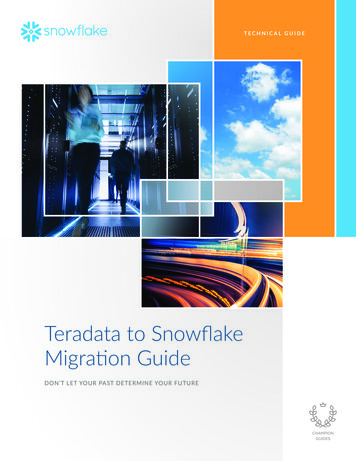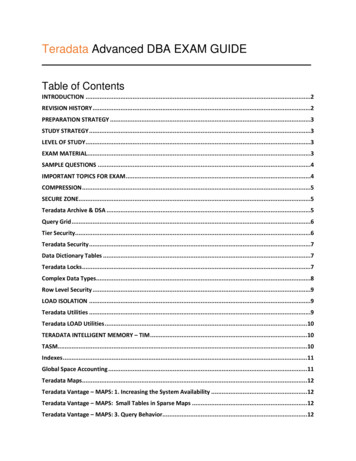
Transcription
Teradata Advanced DBA EXAM GUIDETable of ContentsINTRODUCTION .2REVISION HISTORY .2PREPARATION STRATEGY .3STUDY STRATEGY .3LEVEL OF STUDY .3EXAM MATERIAL.3SAMPLE QUESTIONS .4IMPORTANT TOPICS FOR EXAM .4COMPRESSION .5SECURE ZONE.5Teradata Archive & DSA .5Query Grid .6Tier Security.6Teradata Security .7Data Dictionary Tables .7Teradata Locks .7Complex Data Types.8Row Level Security .9LOAD ISOLATION .9Teradata Utilities .9Teradata LOAD Utilities . 10TERADATA INTELLIGENT MEMORY – TIM . 10TASM. 10Indexes . 11Global Space Accounting . 11Teradata Maps. 12Teradata Vantage – MAPS: 1. Increasing the System Availability . 12Teradata Vantage – MAPS: Small Tables in Sparse Maps . 12Teradata Vantage – MAPS: 3. Query Behavior. 12
Teradata Columnar . 13INTRODUCTION The purpose of this guide is to streamline all the important courses & topics for a candidatewho is preparing for the Advanced DBA Exam.In short, the aim is to make someone’s life easier, by summarizing all the content at oneplace & providing a few tips to help in preparation of the Exam.REVISION HISTORY Revision history table shows the changes, and authors who have worked on document.Version/Changerequest number1.003/07/20202.0 Versiondate13/07/2020Description of changesAuthorFirst iz BhattiContent Added, Formatting /Moeiz BhattiStakeholdersThe below table provides a list of all stakeholders who are interested in this runbook.NameEmailSaqib BukhariRoleSupervisorAdnan MaskeenAdnan.Maskeen@teradata.comAuthorMuhammad BilalMuhamma.bilal3@teradata.comAuthorMubasher HassanMoeiz Ali BhattiAuthorMoeiz.Bhatti@Teradata.comAuthorNote: This Guide has been prepared or assembled by Teradata and is intended for informationalpurposes only and does not guarantee exam success. Some of the information may be dated and maynot reflect the most current release. Any opinions expressed in this Guide are the opinions of theindividual author.
PREPARATION STRATEGY Please keep in mind while preparing that the preparation can be overwhelming.If you follow the following tips and tricks you can prepare for the exam in as less as 2-3 weekseven if you do not have as much hands-on experience.STUDY STRATEGY While starting the study, the strategy to be taken should be to take out the objectives and mapthem to the resource materialsWhat people do is start studying from scratch, book by book which is very hectic and timeconsuming.Selective study is key to attempt the exam in a time effective manner.LEVEL OF STUDY We do not need in depth working details of the features at this level of examination. (it may beneeded in advance levels).The fundamental knowledge like definitions and high-level functionality/features are to beunderstood for every exam objective.Touch each and everything given in the exam objectives and then tally them with the guide weare providing.EXAM MATERIALOrange Books Teradata database MAPs Architecture The Basics 2017-07 TDN0009415 - OrangeBook B035-1099-162K – ResourceUsage Teradata Intelligent Memory Teradata Block-Level Compression with Selected Enhancements through Teradata Database16.0 Load Isolation User Guide Teradata Database 16.00 TASM TDN0001776 Teradata Backup Archive Restore DSA Best Practices Teradata Row Level Security Teradata Secure Zones Link to downloading Orange books a and other study books is given belowhttp://docs.teradata.com/search/books?filters category %2522Orange Book%2522&content-lang en-US
WBT & ILT Courses ILT 25964 Introduction to the Teradata Database OR WBT 26348 Introduction to theTeradata DatabaseILT 25968 Teradata Vantage Advanced SQL Engine Physical Database DesignILT 25969 Teradata Vantage Advanced SQL Engine Physical Database Tuning57040 Teradata Database Administration: Vantage Advanced SQL Engine36916 : Vantage: Optimizing Advanced SQL Engine through Workload Management56941 Teradata Parallel Transporter: Vantage Advanced SQL EngineWBT 53054 Teradata Data Stream Architecture (DSA)WBT 56458 Teradata Query Grid 2.0 Technical OverviewSAMPLE QUESTIONS There are some sample questions at the following link. Go through them onceyou feel your preparation is am andthen click on the "exam prep" tabIMPORTANT TOPICS FOR EXAMListed below are the important topics for the exam. We will cover these in detail as we move forward. CompressionSecure ZoneTeradata Archive & DSAQuery Grid3 Tier SecurityTeradata SecurityData Dictionary TablesTeradata LocksComplex Data TypesRow Level SecurityIndexesGlobal Space AccountingTD MapsColumnarTeradata UtilitiesLoad IsolationTeradata Intelligent MemoryTASM
COMPRESSION Thoroughly read Block level compression (BLC), Multi value compression (MVC) andAlgorithmic Compression (ALC).Preferred guide to prepare for compression is orange book (Block-Level Compression withSelected Enhancements through Teradata Database 16.0)DBS parameters with respect to block level compressionCompare different scenario in which case BLC, MVC or ALC will be applied.Study how a combination of multiple compression techniques can be applied.How BLC related DBS changes will impact on the compression, e.g.BlockLevelCompression, TempBLCThresh. How their combination work with table level BLCparameters.We’ve attached a guide we’ve created, that summarizes some key point of compression.CompressionMethods.docxSECURE ZONE Advantages of secure zone, why it is used and what is different compare to normal TeradatasecurityThoroughly read and understand difference between multiple users/databases involve insecure zone e.g. root, secure zone dba, zone guest, zone member etcStudy access rights of every user inside & outside the zone.We’ve attached a guide we’ve created, that summarizes some key point of compression.Read different scenarios and implementation of secure zone user cases like Multinational orConglomerate, Sandbox and Multi-tenancy. These details are discussed in detail within theorange book “Teradata Secure Zones”SECURE ZONES.docxTeradata Archive & DSA Study the comparison between ARC and DSA.While migrating from ARC to DSA how to map ARC full and partition backups to DSA full,delta and cumulative backups.Study the different type of backup option in ARC, e.g. AMP Keyword, CLUSTER Keyword,RELEASE LOCK Keyword etc. attached is the document to read ARC options in details.Study the difference between DSU and DSE, and DSA different component e.g. DATASTREAM MAIN, DATA STREAM CONTROLLE, DSA NETWORK CLIENT, NETBACKUP
ACCESS MODULE, DD BOOST ACCESS MODULE, AWS S3 ACCESS MODULE, AZUREACCESS MODULE, DSA GRAPHICAL USER INTERFACE and DSA COMMAND-LINEINTERFACEDSA – comparison between FULL, DELTA and CUMULATIVE backups, and whileimplementing backup with DSA what approach to be followed.An example scenario is mentioned in the document attachedBAR Concepts.docxQuery Grid Study the components of GQ, and what are required while creating different components, forexample (AUTHORIZATION, FOREIGN SERVER, LINKS). Refer to “Teradata 2.10QueryGrid Installation and User Guide”We’ve attached a document that contain some of the important concepts of Query Grid.QUERY GRIDCONCEPTS.docxTier Security Acquisition: As the first point of entry into the data warehouse, raw data is acquired fromvarious source systems such as mainframe, server, etc.Integration: The integration layer is primarily responsible for integrating data from multiplesystems both normalized and potentially de-normalized. It also may create common metricsand summaries which are widely used within an organization.Access: The access layer’s primary responsibility is to provide easy access to the datausing various analytic methods.How can we secure data between different layers, and while modeling what will be theconsiderations populating data into different layers
Teradata Security For Security, the ppt “De-mystifying LDAP and SSO Teradata Database ExternalAuthentication” by browning is very important. There also is a WBT on Teradata that coversthe same ppt.Different mechanisms of authentication in Teradata e.g. Supports 5 pre-defined securitymechanismso Teradata Method 1 (TD1)o Teradata Method 2 (TD2)o LDAPo Kerberos (KRB5)o SPNEGOo IP FiltersTeradata Generic Security Services (TDGSS) Configuration, read brief details of belowmentioned fileso TdgssLibraryConfigFile.xmlo TdgssUserConfigFile.xmlo run tdgssconfigData Dictionary Tables All ResUsage table and their structures, should be on your fingertips. The most important areResUsage MacrosTables DBC.EventLogs, DBC.SessionInfo and DBS.LogonOff differences and which one isused in case to verify session limits. How to use SessionInfoV for PE analysisDBQL tables structure and which is used for forecasting. Scenarios like which columns toidentity skewness and PJI etc.We’ve created a small document that contains key points of Res Usage Views & Macros.The CPU & AWT ones are really important.Resource UsageLogging Views Macros.docxTeradata Locks Read in detail about different kinds of locks in Teradata, e.g. Read, Write, Access, Exclusive,HutDifference of locks acquired while access and load isolation lock.Scenarios to identify what lock acquired for the specific tables with partition and with andwithout access locking
Ready explain plains to identify which SQL is locking how many partitions or locking on rowhas while accessing or updated data.Lock shRowHash in aPartitionRangeRowKeyWhat is Lockedall rows of all tables in the specified database and their associated secondaryindex subtables.all rows in the specified base table and in any secondary index and fallbacksubtables associated with it.all underlying tables accessed by the specified view.the primary and fallback copy of rows in a partition for the specified table orsingle-table view. The table must be row partitioned.This lock permits other users to access the data in the table that are not in thesame partition.the primary and fallback copy of rows in a range of partitions for the specifiedtable or single-table view. The table must be row partitioned.This lock permits other users to access the data in the table that are outsidethe specified partition range.the specified primary or fallback copy of rows sharing the same row hash valuefor the specified table or single-table view. For a row-partitioned table, this locklevel applies to the row hash value for all partitions.the specified primary or fallback copy of rows sharing the same row hash valuefor the specified table or single-table view in a range of partitions. The tablemust be row partitioned.the specified primary or fallback copy of rows sharing the same rowkey(partition and row hash value) for the specified table or single-table view. Thetable must be row partitioned.A rowkey-level lock permits other users to access other data in the table thatdo not have the same rowhash or partition value.Complex Data Types Difference between JSON, BSON and UBJSON.For example, which data type is fast for loading and while accessing?Document is attached for complex data types as well as a link for macros & functions usedfor complex data types in Teradata.Macros and functions used for complex data types in dita/topic?dita:mapPath bgi1512081870828.ditamap&dita:ditavalPath TD DBS 16 20 Update1.ditaval&dita:topicPath nuf1532387510243.dita
JSON, BSON.docxRow Level Security Studying the implementation of RLS is very important.Teradata row-level security (RLS) allows you to restrict data access on a row-by-row basis inaccordance with your site security policies. Row-level security policies can be used inaddition to the standard GRANT privileges to provide a finer level of access control to tabledataWe’ve created a document of RLS, that contains the key points.Teradata Row LevelSecurity.docxLOAD ISOLATION A feature at DDL level, which permits reading rows during an insert. Only the committedrows are read.It is important to review the Orange Book “Load Isolation User Guide Teradata Database16.00 2016-05”We have summarized some key points of Load Isolation, after reviewing the Orange bookmentioned above. The key points are attached below.LOADISOLATION.docxTeradata Utilities Teradata Utilities & their commands are an important part of the exam.One should thoroughly review all the Teradata Utilities mentioned in Module 8 from theOrange Book “Teradata Warehouse Administration 16.20”It is recommended to practically use these utilities by setting up a Virtual Machine & runningthese utilities.We have summarized key commands & key utilities in the document attached belowTeradataUtilities.docx
Teradata LOAD Utilities Teradata LOAD Utilities do not cover an extensive part of the exam. However it is stillimportant to understand the basics of FASTLOAD, MultiLoad & TPT.TPT Operators should be reviewed & the candidate should understand the comparsion ofOPERATORS between fastload, Multiload & TPT.A summarized guide of LOAD Utility Comparison is attached below, which should help inunderstanding the key points.Load Utilities.docxTERADATA INTELLIGENT MEMORY – TIM Teradata Intelligent Memory (TIM) Phase-2 provides the ability to: Adjust the File Segment(FSG) TIM Very Hot (VH) cache size without a reset (tpareset)We reviewed the Orange Book “Teradata Intelligent Memory 14.10”, but if the latest versionis available, that would be recommended.We have summarized key commands & key utilities in the document attached belowTIM.docxTASM TASM covers an important & extensive part of the Adv DBA Exam. It is recommended thatone reviews TASM & its features practically before appearing for the examWe reviewed the Orange Book “Teradata Active System Management 16.20”, & we highlyrecommend that a candidate reviews this book.The Candidate should understand the difference between TASM & TIWM. Differencebetween SLES 10 & SLES 11 should also be studied.Review all options of exceptions that are available on TASM.The exam will have scenario based questions for TASM. It is important to understand whattype of queries run in TACTICAL, what runs in SLG & how to use the timeshare feature ofTASM.Review how to control ETL Utilities through TASM Options that are provided.
Indexes Indexes such as PI, SI, Join Indexes and its types need to be reviewed.How to use SI on a a Join Index needs to be reviewed. These details are available in theOrange Book “Physical Database & Design V 16.20”We’ve summarized some key points related to Teradata Indexes in the document attached.TERADATAINDEXES.docxGlobal Space Accounting Global Space Accounting refers to the calculation of total available space at AMP level andglobal level by using provided skew percentage factors and global skew percentage factors.For more details on Global Space Accounting, please refer to the link below.A short example is also given below for dita/topic?dita:mapPath kae1480972952938.ditamap&dita:ditavalPath changebar rev 16 10 exclude audience ie.ditaval&dita:topicPath twf1493612468221.ditaExample:Skew factor and soft limits can be cumulative. For example, consider the following numbers: Global limit: 800 MBSoft limit: 10 percentPer-AMP limit on a 4-AMP system: 200 MBSkew factor: 25 percentWith these numbers, the global limit can exceed the 800 MB limit by 10 percent (to 880 MB). Inaddition, an AMP can exceed the 200 MB limit by 25% (to 250 MB) if the total across all AMPsdoes not exceed 880 MB. Each of the AMPs can also receive an additional 20 MB because ofthe global soft limit. The cumulative effects of the skew factor and global soft limit can increasethe maximum possible space allotment to an AMP to 250 20 270 MB, as long as the totalspace used across all AMPs does not exceed 880. The user will receive an error message ifeither of the following limits are exceeded: The global limit of 880The per-AMP limit of 270
Teradata Maps Teradata Maps is an important part of the exam. The best way to review Teradata Maps is toreview some tech-bytes/videos available from Carrie Ballinger, Sr Technologist (TeradataTechnology & Innovation Office)We found these videos on Youtube, but We’re sure they should be easily available elsewhere. The video References are given below.We’ve also added a small document, which covers key points of Teradata Maps.TitleLinkTeradata Vantage – MAPS: 1. Increasing the SystemAvailabilityhttps://www.youtube.com/watch?v 8PHGL9OLhF0Teradata Vantage – MAPS: Small Tables in Sparse Mapshttps://www.youtube.com/watch?v vKZq8AmPoGkTeradata Vantage – MAPS: 3. Query Behaviorhttps://www.youtube.com/watch?v T 7mAe1bJSYTERADATAMAPS.docx
Teradata Columnar Teradata Columnar is a performance feature and physical design feature that offers theability to partition a table by column, or to combine Column Partitioning (CP) and rowpartitioning on the same table.A key benefit of Columnar is the reduction of I/O and a smaller storage size, which can leadto faster query execution times. Four most common approaches to implement CP table:Pick a very big table with considerable number of columns but most queries access only asubset of columnsDefine the table with primary AMP indexingUse hybrid partitioning if a date-time column on that table is frequently used as a predicate,and for deleting by row partitionDo very simple partitioning, each column in its own partition.Good candidates for Columnar Table must be Multiset and should be greater than 1GB per AMPTable has greater than 50 columnsFew or no rows are updatedFew rows are deleted other than by means of row-partitioned tablesLoading by means of large INSERT-SELECT operation is acceptableNumber of predicate columns in the queries are relatively small, ideally one column in aquery is highly selectiveIndividual queries that access the table only require a small subset of the total columns, andthe columns being accessed vary (Note: If the same columns are accessed frequently, thena sparse join index would be a reasonable alternative to columnar)
57040 Teradata Database Administration: Vantage Advanced SQL Engine 36916 : Vantage: Optimizing Advanced SQL Engine through Workload Management 56941 Teradata Parallel Transporter: Vantage Advanced SQL Engine WBT 53054 Teradata Data Stream Architecture (DSA) WBT 56458 Teradata Query Grid 2.0 Technical Overview
